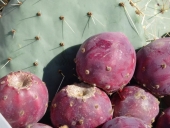
 3
3




Shawn Jadrnicek
Farm Manager Clemson University Organic Farm
Author of "The Bio-Integrated Farm" http://www.amazon.com/The-Bio-Integrated-Farm-Revolutionary-Permaculture-Based/dp/1603585885
 2
2




Shawn Jadrnicek
Farm Manager Clemson University Organic Farm
Author of "The Bio-Integrated Farm" http://www.amazon.com/The-Bio-Integrated-Farm-Revolutionary-Permaculture-Based/dp/1603585885




Idle dreamer
 1
1




I would love to obtain pads from a good fruiting variety; none of mine fruit very well.
Buy Our Book! Food Web: Concept - Raising Food the Right Way. Learn make more food with less inputs
Off Grid Homesteading - latest updates and projects from our off grid homestead




Shawn Jadrnicek wrote:A local brewery said they would buy all the fruit I can produce
Buy Our Book! Food Web: Concept - Raising Food the Right Way. Learn make more food with less inputs
Off Grid Homesteading - latest updates and projects from our off grid homestead




Idle dreamer




Abe Connally wrote:
Shawn Jadrnicek wrote:A local brewery said they would buy all the fruit I can produce
That's an interesting resource. What do they pay?
Shawn Jadrnicek
Farm Manager Clemson University Organic Farm
Author of "The Bio-Integrated Farm" http://www.amazon.com/The-Bio-Integrated-Farm-Revolutionary-Permaculture-Based/dp/1603585885




Shawn Jadrnicek wrote:Thanks for the tip on using boiling water to remove the glochids. That will save me a ton of time. The brewery said they would pay $1/pound but I don't have a lot of fruit yet so we'll have to see in a few years.
Buy Our Book! Food Web: Concept - Raising Food the Right Way. Learn make more food with less inputs
Off Grid Homesteading - latest updates and projects from our off grid homestead
 2
2





Pecan Media: food forestry and forest garden ebooks
Now available: The Native Persimmon (centennial edition)




Idle dreamer




Buy Our Book! Food Web: Concept - Raising Food the Right Way. Learn make more food with less inputs
Off Grid Homesteading - latest updates and projects from our off grid homestead




Xisca - pics! Dry subtropical Mediterranean - My project
However loud I tell it, this is never a truth, only my experience...
 1
1








Idle dreamer
 2
2












Idle dreamer








 1
1




Yes, I'm that David The Good. My books are here: http://amzn.to/2kYcCKp. My daily site is here http://www.thesurvivalgardener.com and my awesome videos are here https://www.youtube.com/subscription_center?add_user=davidthegood
 2
2





Idle dreamer
 2
2




Yes, I'm that David The Good. My books are here: http://amzn.to/2kYcCKp. My daily site is here http://www.thesurvivalgardener.com and my awesome videos are here https://www.youtube.com/subscription_center?add_user=davidthegood

 1
1




 2
2




Daniel Kaplan wrote:
Peter Heffernan wrote:Beware!
Prickly Pear rendered 58 MILLION ACRES UTTERLY UNUSABLE in Australia in the early 19th century, because birds so quickly spread seeds everywhere!
Be very careful not to make the solution into THE PROBLEM!
Somewhere I read about burning the spines off and using them as cattle forage during drought. I suppose you'd have to be careful not to torch the whole place but it seems that you could keep them in check that way. Or you could have it as a backup food supply that your livestock wouldn't normally go for. Add another use to the stack.
Gail Gardner @GrowMap
Small Business Marketing Strategist, lived on an organic farm in SE Oklahoma, but moved where I can plant more trees.




David Goodman wrote:I've considered moving to an arid climate just so I can grow more varieties of cactus, prickly pear in particular. Thanks for starting an awesome thread.
Gail Gardner @GrowMap
Small Business Marketing Strategist, lived on an organic farm in SE Oklahoma, but moved where I can plant more trees.




Tyler Ludens wrote:Prickly Pear fruits taste a little like slightly sweet dirt to me.
Gail Gardner @GrowMap
Small Business Marketing Strategist, lived on an organic farm in SE Oklahoma, but moved where I can plant more trees.



 1
1




![Filename: 13466025_1115155425194339_7819378395961721715_n.jpg
Description: [Thumbnail for 13466025_1115155425194339_7819378395961721715_n.jpg]](/t/49834/a/41469/13466025_1115155425194339_7819378395961721715_n.jpg)
![Filename: 13419259_1115155288527686_3100593777318549927_n.jpg
Description: [Thumbnail for 13419259_1115155288527686_3100593777318549927_n.jpg]](/t/49834/a/41470/13419259_1115155288527686_3100593777318549927_n.jpg)

ex IT technician retired to a farm in Morocco and now almost fully converted to permaculture and organic farming




Khalid Aassila wrote:I planted prickly pears as a fencing around my 6 hectares orchard which is located in northern Morocco on a 1300meters high foothill and it is doing great already most of them are flowering just months after they were planted .....great plant that requires little to no watering and maintenance , I am fully satisfied
















ex IT technician retired to a farm in Morocco and now almost fully converted to permaculture and organic farming
 2
2




Tyler Ludens wrote:I've not tried rooting the pads that you can sometimes find at the grocery, but you might try that.
 4
4




Invasive plants are Earth's way of insisting we notice her medicines. Stephen Herrod Buhner
Everyone learns what works by learning what doesn't work. Stephen Herrod Buhner
 1
1




Idle dreamer
 1
1




Permaculture market farming, plant breeding and perennial grains: http://jasonpadvorac.com
 2
2




soloenespana.wordpress.com




Chadwick Holmes wrote:Pennsylvania is no place for the prickly pear.... But I am a huge fan of alliteration so I had to come say hats off to the thread name!




Jenna Ferresty wrote:Does anyone know how far north they will overwinter and produce fruit?

|
If you have a bad day in October, have a slice of banana cream pie. And this tiny ad:
montana community seeking 20 people who are gardeners or want to be gardeners
https://permies.com/t/359868/montana-community-seeking-people-gardeners
|








